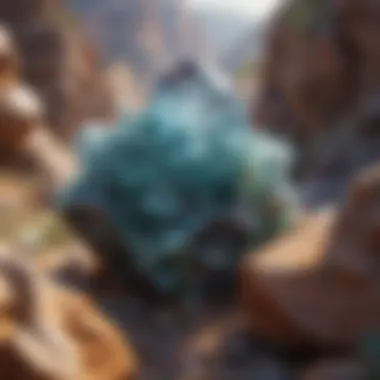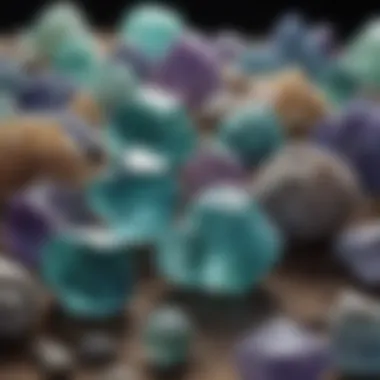Fluorite: Unveiling Its Geological and Industrial Wonders


Intro
Fluorite, a mineral with intriguing properties and aesthetic appeal, commands attention in the worlds of geology, industrial applications, and collectibles. This article will unravel the complexities of fluorite, providing a detailed exploration of its formation, significance, and diverse uses. The discussion extends from fundamental characteristics to more advanced topics, ensuring both novices and experienced enthusiasts gain valuable insights.
Rock and Fossil Identification
Identification of fluorite and related specimens is an essential skill for collectors and geologists alike. Understanding the types of minerals one may encounter is the foundation of this hobby.
Types of Fluorite
Fluorite encompasses several varieties based on color and formation. Common samples include:
- Purple Fluorite: Known for its rich violet hues, often presented in cubic crystals.
- Green Fluorite: Ranging from pale to dark green, frequently translucent and inviting.
- Blue Fluorite: A rarer variety, blue fluorite can display stunning shades from azure to deep navy.
- Yellow Fluorite: This variety reflects shades from light golden to bright yellow, often with a vibrant luster.
- Colorless Fluorite: Remarkably transparent; this type often acts as a substitute for crystal in jewelry.
Characteristics to Look For
To identify fluorite, one must examine certain characteristics, such as:
- Color Variations: Be aware of the color range as a hint toward your specimen type.
- Cleavage: Fluorite has perfect cleavage in four directions, evidenced by smooth faces on broken edges.
- Hardness: This mineral registers a hardness of 4 on the Mohs scale, allowing for easy scratching in tests.
- Fluorescence: Notably, under UV light, fluorite can exhibit brilliant fluorescence, a distinctive feature of some specimens.
Tools for Identification
Utilizing the proper tools enhances the accuracy of identifications. Recommended equipment includes:
- Magnifying Glass: A simple yet effective tool to view small details.
- Geological Hammer: For safe extraction and to attain clear cleavage surfaces.
- Streak Plate: Testing the streak color can provide further identification clues.
Collecting Tips and Techniques
Successful collecting requires preparation and awareness of methods that increase efficiency and safety.
Best Practices for Collecting
- Research Locations: Different markets and natural sites offer distinct specimens, seek areas known for colorful fluorite deposits.
- Join a Community: Engaging with local clubs or online groups can yield tips and shared findings.
- Record Your Findings: Journaling helps create a history of your collection and location data.
Locating Prime Collecting Sites
- Local Quarries: Often the richest in exposure to minerals like fluorite.
- Rock Shows: A gathering of collectors and vendors can provide both specimens and information.
- Sci-Tech Exhibits: Many museums host seasonal geology displays highlighting local finds.
How to Safely Extract Specimens
Practice care during extracting:
- Safety Goggles: Protect against flying debris while leveraging rock hammers for disruptions.
- Buffing Pads: Health must be acheived through stability on bonds.
- Avoid Striking Hard Surfaces: Taking search stats seriously prevents valuable breakage.
Preservation and Display
Ensuring sustained integrity of specimens adds to their value and aesthetic appeal when displayed or kept.
Techniques for Preserving Rocks
Maintaining appearance and preventing degradation is vital.
- Use Preservation Aids: Coatings like Paraloid can offer added protection against moisture and surface degradation.
- Cleanthoroughly with Water: Do not scrubbing too harshly to avoid losing any reflective features.
Proper Storage Methods
- Use Soft Cloth Bags: Isolation minimizes scrap risks.
- Temperature Control: Climate-controlled environments help prevent energy stresses, leading to material breakdown.
Creative Display Ideas
Consider unique approaches to showcasing crystals:
- Shadow Boxes: Causes light rays interact uniquely for added viewing pleasure.
- Rotating Displays: Gives rental imaginers a dynamic experience amidst each view.
Geological Insights
Understanding the underlying geology enhances appreciation and ensures more informed collecting.
Geological Formations and Processes
Fluorite often forms in igneous and sedimentary deposits:
- Hydrothermal Veins: Common within areas experiencing volatile movements.
- Sedimentary Basins: Where hydrologic activity captures embedding minerals.
Historical Significance
Fluorite has held fascination for centuries, tying into various cultures and applications, from flux in iron smelting processes to its uses in lapidary arts. Knowing this context can deepen one's appreciation.
Notable Discoveries
Significant finds include the burial sites of ancient civilizations and modern locations worldwide, drawing interest to comparative studies of functioning societies circling usages.


The multifaceted nature of fluorite makes it a remarkable area of study. It appeals universally to hobbyists, professionals, and collectors – enhancing the bonds across its expansive history.
Prologue to Fluorite
Fluorite is a mineral known for its diverse characteristics and its wide-ranging applications across industries and collectables. The purpose of introducing fluorite in this article is to shed light on its complexities. Fluorite is both significant in terms of geological study and practical usage. It has unique properties that enhance its value in various sectors, from industrial applications to personal collections. Understanding fluorite's details prepares the reader for a comprehensive exploration of what makes this mineral so intriguing.
Defining Fluorite
Fluorite, with the chemical formula CaF₂, is a mineral composed of calcium and fluorine. It is typically found in hydrothermal veins, and it can also appear in sedimentary deposits. The natural crystal habit of fluorite can range from cubical forms to massive and granular varieties. Its definition includes more than its chemical breakdown; it extends to the historical, industrial, and aesthetic values attributed to the mineral.
Basic Properties
The properties of fluorite make it fascinating not only to scientists but also to collectors. Some essential properties include:
- Hardness: On the Mohs scale, fluorite ranks between 4 and 5. This means it is softer than some other minerals, allowing for ease of processing in industry.
- Color Variety: Fluorite exhibits a wide range of colors due to impurities within its structure. Common shades include purple, green, yellow, and clear forms.
- Cleavage: It has perfect cleavage in four directions, which allows it to break with smooth surfaces. This aspect is crucial for both mineral collectors and industrial applications.
- Transparency: Depending on its purity, fluorite can be transparent, translucent, or opaque.
By examining the skeletone of these basic properties, one can appreciate well where fluorite stands among other coveted minerals.
Geological Formation of Fluorite
Fluorite's geological formation is fundamental to understanding its significance both as a mineral and within the broader geological context. This segment encapsulates the intricate processes and specific compositions that lead to the creation of fluorite deposits. A solid grasp of these fundamentals enriches the appreciation of fluorite's unique properties and its pivotal role in multiple industries.
Mineral Composition
Fluorite is primarily composed of calcium fluoride (CaF2). This simple chemical formula belies the complexity encapsulated in its crystal structure. Variation in the mineral’s properties often depends on the trace elements present during formation. Common impurities include rare earth elements, barium, and even manganese, which can impart distinct colors to the fluorite, ranging from purple to green.
Typical mineral composition of fluorite includes:
- Calcium Fluoride (CaF2)
- Impurities: Barium (Ba), Cerium (Ce), and Yttrium (Y)
- Presence of other halides
This composition allows for distinct optoelectronic properties, making fluorite not only useful but also visually striking. Characteristics derived from these inclusions not only appeal to collectors but are also of significant interest to mineralogists and industries that exploit these unique aspects.
Formation Processes
Fluorite predominantly forms under hydrothermal conditions, wherein mineral-rich water flows through rock fractures while cooling and precipitating minerals. This process generally takes place during the late stages of igneous rock formation or during the metamorphism of sedimentary rocks. As the fluid cools, the solubility of minerals often decreases, triggering the formation of crystalline structures as fluorite starts to crystallize from the solution.
Key formation environments for fluorite include:
- Hydrothermal veins
- Veins formed in sedimentary continental regions
- Confirmation in limestone or granite sedimentation
These processes signify an array of geological actions through time, ultimately leading to concentrated deposits of fluorite found within various terrains. Understanding these fundamental processes is essential as it connects the mineral's beauty to the intricate dance of geological forces and history spanning eons.
Important: Fluorite's striking characteristics have contributed to its popularity, particularly among collectors. The interplay of its mineral composition and formation processes can significantly affect its attributes.
Occurrence of Fluorite
Fluorite is not merely a visually stunning mineral; its importance extends beyond aesthetic appeal. It's a critical component in various industries, reflecting a significant function in modern manufacturing and cultural contexts. Understanding the occurrence of fluorite within the Earth's crust is essential for comprehending its practical applications and cultural relevance. Regions where fluorite is found often reveal a treasure of geological history and provide insights into mining practices.
Global Deposits
Fluorite deposits exist across multiple continents, each presenting distinct geologic attributes. Noted for both its abundance and variety, these global deposits ensure a continuous supply that meets industrial demand.
- North America: The United States has significant deposits, with Kentucky and Illinois at the forefront. The famous Kerner and Rosiclare Mines have long been celebrated for producing high-quality fluorite crystals.
- Europe: Countries like Spain and France hold substantial reserves where fluorite exhibits stunning color variations and forms. The economic roles of these deposits are vital for regional mining industries.
- Asia: In China, fluorite is mined extensively, bolstering its status as a primary producer globally.
- Africa: Countries such as South Africa offer expansive deposits, enhancing the continent's position in the market.
Notable Locations
Various notable locations quaL**ifY as hotspots for enthusiasts and collectors, often yielding remarkable specimens.
- The Multiple Mines of Southern Illinois: These areas produce large octahedral crystals, appealing for both collectors and gem enthusiasts. Each delve reveals an opportunity for miners to uncover stunning cubes and combinations of colors.
- Cerro Blanco, Peru: Known for producing exceptional prehnite and calcite, besides fluorite, collectors prize this locale.
As we unravel explorations into fluorite occurrence, each layer unfolds promising avenues. The unique arrangements found in specific deposits offer avenues not only to discern this beautiful mineral but also to hold it, capture its essence, and appreciate its past usefulness cobbling harmoniously through our industrial history.
Physical Characteristics of Fluorite
Fluorite possesses a number of distinct physical characteristics that considerably influence its aesthetic appeal and functionality. The understanding of these characteristics is essential for both collectors and industrial users alike. Collectors often seek out unique specimens, while industries depend on recorded attributes for commercial applications. Below are the key physical dimensions of fluorite that warrant exploration.
Color Variations
Fluorite is renowned for its diverse range of colors. It can be found in shades including, but not limited to, purple, green, yellow, blue, and even colorless forms. These variations arise due to the presence of various impurities within the crystal structure. For example:
- Purple fluorite is often linked with the presence of yttrium.
- Green hues usually arise from iron content.
- Blue fluorite may contain trace amounts of cerium.
In addition to these colors, some specimens are notable for their banding. This occurs due to the layered growth of the mineral, varying in color and saturation. Such characteristics boost the visual attractiveness, making certain pieces extremely desirable for collectors.
Crystal Structures
The crystal structure of fluorite is integral to its classification. Fluorite crystallizes in the cubic system and is generally seen as octahedral crystals. Often, these can exhibit smooth faces with well-defined edges. The unique isometric symmetry contributes to the mineral's unique appearance.
Additionally, the crystalline beauty of fluorite, especially in its natural forms, can affect market value. Collectors pay high prices for well-formed, transparent specimens since these features are less common.
Cleavage and Fracture
Another crucial characteristic of fluorite is its cleavage patterns. Fluorite has a distinctive cleavage in four directions, which can cause it to break into irregular fragments. This cleavage is readily observable and serves as a valuable identifier for the mineral.


In contrast, the fracture surfaces are often uneven and not distinctly defined. Observing and understanding these physical traits is relevant not only for accurate identification but also for discussing the implications in gem-cutting processes applied in the jewelry industry.
“The unique physical characteristics of fluorite directly impact both its practical use and aesthetic value.”
Fluorite in Industrial Applications
Fluorite plays a significant role in various industrial applications, making it a valuable mineral in today’s manufacturing processes. Its unique properties lend to multiple uses, particularly in metallurgy, optics, and chemical industries. Understanding these applications is essential, especially for enthusiasts and professionals. By knowing where fluorite fits in industries, we can appreciate its multifaceted nature.
Use in Metallurgy
In metallurgy, fluorspar, a mineral form of fluorite, is critical for the production of iron and steel. Its primary function as a flux is to reduce the melting point of ores, aiding in the purification process by removing impurities. The smooth flow improves the efficiency of the smelting operation. Furthermore, the addition of fluorite enhances the quality of the final metal product. It helps achieve higher durability and stability in metallurgical compositions.
In addition to steel production, fluorite is increasingly used in non-ferrous metal smelting. This extends to metals like aluminum and copper, where rigorous purification is essential. The market demand shapes the importance and versatility of fluorite in these processes.
- Key Benefits of Fluorite in Metallurgy:
- Reduces melting point of materials.
- Enhances purity of metals.
- Improves overall metallurgical process efficiency.
Role in Optical Products
Fluorite is highly valued in the optical world due to its low dispersion rate and high transmission of ultraviolet light. Certain types of fluorite lenses are popular in high-quality cameras and telescopes. Products incorporating fluorite exhibit reduced aberration properties, creating distinctly clear images. Optical systems utilizing these lenses typically possess superior performance.
The interest in fluorite's optical properties also extends to scientific instruments. Optical observatories favor fluorite components for their sensitivity and clarity. The balance of refractive properties is crucial in making precise measurements and casting a strong impact in fields like astronomy and microscopy.
- Fluorite Features in Optical Products:
- Low dispersion qualities enhance clarity.
- High UV transmission promotes performance in harsh environments.
- Decreases optical aberrations for sharper images.
Importance in Chemical Industries
In the chemical sector, fluorite serves as a vital source of fluorine. Pure chemical-grade fluorite is essential for producing hydrofluoric acid, which has numerous applications. Hydrofluoric acid, primarily, plays a crucial role in producing fluorocarbons and in melting processes of materials like glass.
Moreover, fluorine’s importance extends to pharmaceuticals, where it is used to synthesize various compounds. There is a growing attention towards ensuring sustainable practices in fluoride production processes. As global demand for fluorinated products continues to rise, the chemical uses of fluorite could expand even further.
- Notable Uses of Fluorite in Chemical Industries:
- Source for fluorine gas.
- Key component in producing hydrofluoric acid.
- Integral for synthetic processes in pharmaceutical developments.
Fluorite stands as a cornerstone mineral in numerous industrial applications, demonstrating its diverse functionalities and essentiality across sectors such as metallurgy, optics, and chemicals. The understanding of these potential benefits aids collectors and industry professionals alike.
By delving into these applications, we grasp deeper insights into fluorite's significance beyond its aesthetic appeal—allowing for a thorough appreciation of both its practical importance and geological heritage.
Fluorite in the Collection Community
Fluorite holds a notable position within the collection community, attracting enthusiasts for its vivid colors and well-defined crystal forms. As collectors engage deeply with minerals, their appreciation goes beyond beauty to include scientific, historical, and even investment considerations linked to fluorite.
Collector Preferences
Collectors often seek fluorite for its unique aesthetic appeal. The complexities of its crystal structures and color variations enhance its allure. Different specimens are valued based on clarity, coloration, and the presence of zoning, where different hues accumulate in certain layers. For example, purple fluorescents like Purple Augite are often sought after for the richness of their color. Moreover, peculiar habits like fluorite octahedra captivate many individuals. The stability of fluorite in various environments also makes it gratifiying for collectors as their selection can last.
In practical terms, collectors may lean toward fluorite from specific localities renowned for certain hues, such as the blue samples from Rogerley Mine in England or exquisite forms from China. These preferences often involve networking with other collectors and visiting specialized mineral shows, which provide insights into market values and shifting tastes.
Factors to consider regarding fluorite in a collection can include:
- Color depth and clarity
- Crystal habits (octahedral vs. cubic)
- Locality specifics
- Historical significance
Market Trends
Trends within the fluorite market reflect shifts in both aesthetics and industrial applications. Recently, there has been an increasing interest in top-tier fluorite specimens with exceptional transparency or unique coloration. This is influenced by social media platforms where collectors share stunning photographic depictions of their findings.
Moreover, sustainability is on the minds of many high-end buyers. Environmental consciousness may even prompt adjustments in who is purchasing these minerals. The growth in interest for ethical sourcing has begun to alter available specimen markets. Underlining this trend, some sellers are integrating conditions that ensure more responsible sourcing strategies.
There's also a structured online marketplace where transactions take place efficiently. Platforms such as Reddit and specialized online shops create spaces for discussions on valued specimens and market topics.
This market landscape not only caters to seasoned collectors but also invites new enthusiasts to immerse themselves. The evolving nature of collectible fluorite is both an assurance of its continuing draw and a medium for keeping cultural and geological heritage alive. > "The value of fluorite specimens extends far beyond their physical attractiveness, intertwining the realms of aesthetic appreciation, scientific interest, and market implication."
Identification of Fluorite
Identifying fluorite is crucial for both collectors and those involved in its commercial applications. A keen understanding of its characteristics can help safeguard against imitation and misinterpretation. Accurate identification enhances the appreciation of this fascinating mineral in any collection. Collectors should prioritize proficiency in recognizing authentic fluorite. This knowledge aids not only in collection value but also in building a trustworthy reputation within the rock and mineral community.
Visual Characteristics
Fluorite exhibits a range of visual characteristics that make it distinct. One of its most notable features is its color, which can vary significantly from colorless to shades of purple, blue, green, and yellow. Additionally, fluorite often displays zonal coloration: different areas of a single crystal may have varied hues. These visual aspects are enhanced in translucent specimens where light can pass through, showcasing the brilliant interiors.
Another important visual trait is the crystal habit. Fluorite typically crystallizes in the isometric system, forming cubes or octahedral shapes, sometimes amalgamated. Clear or deep-colored specimens can serve as stunning centerpieces in collections, often requiring close inspection to discern tiny inclusions or surface abrasions.
You may notice the distinct luster of fluorite. It often exhibits an unmistakable glassy or vitreous shine, adding to its allure. Observing these characteristics can assist in quick identification, allowing collectors to make informed decisions and enhance their overall understanding of fluorite.
Testing Methods
The process of identifying fluorite can be supplemented further through various testing techniques. A straightforward method is the streak test. Scraping the mineral against unglazed porcelain can produce a characteristic white streak, a reliable indicator for identification.
Another method involves assessing the hardness of the specimen. Fluorite has a Mohs hardness rating of 4, meaning it can be scratched by more durable minerals but may scratch softer ones. Testing this characteristic can greatly improve identification accuracy.


Acid reaction tests may also offer insight into whether a mineral is actually fluorite. Fluorite is generally insoluble in dolomite-fluxed hydrochloric acid, so running this test will help confirm its identity. Depending on your tools and expertise, you may also consider advanced methods like polarized light microscopy. This requires specialized knowledge but can yield clear determination as to if the specimen is fluorite.
By familiarizing yourself with both visual characteristics and employable testing methods, any collector can confidently identify fluorite from varieties that may resemble it. This ability not only bolsters one’s collection but significantly enriches the knowledge share in the wider collecting community.
Fluorite and Its Varieties
Fluorite, known for its stunning array of colors and forms, exhibits significant variations that both aesthetic and scientific inquiries find interesting. Understanding the different varieties enhances appreciation and offers valuable insights, whether for collectors or for applications in various industries. Each type contributes unique characteristics that highlight the complexity of this mineral.
Different Color Forms
Fluorite displays a wide spectrum of colors which makes it a prime specimen among collectors. Common hues include purple, green, blue, and even colourless varieties. These colors can display banded patterns, where different shades merge together, enhancing their visual appeal. The cause of these diversifications often links to trace elements such as inclusions of yttrium, which can infuse the crystalline structure with vibrancy. Each color variety may carry specific identifiers, helping both collectors and geologists alike to categorize samples.
- Purple Fluorite: Regarded highly, this form is often sought for its rich depth and symbolizes creativity. Purple can range from light lavenders to almost black tones.
- Green Fluorite: Commonly found, green variants are known as fluorspar and are frequently intersected by clear bands, giving an inviting charm to displays.
- Blue Fluorite: Blue hues are strikingly rare. Their appeal often leverages study, as owners observe the clearer banding and thinner forms which distinguish them.
- Colorless Fluorite: Such forms predictably maintain the same optical qualities as gem-grade crystals, exhibiting clarity that greatly enchants the eye.
Collectors desire samples from different locations showcasing these colors to enhance collection diversity.
Natural vs.
Synthetic Fluorite
Both natural and synthetic fluorite have applications within industrial practices and the collector market. Ensuring clear distinctions between the two aids enthusiasts in navigating purchases effectively.
Natural fluorite forms through geological processes over millennia, reflecting nature's unprocessed art. On the contrary, synthetic fluorite is produced through laboratory methods, often enhancing optical properties and assuring blemishless appearances. Although synthetic fluorite diminishes the perceived rarity compared to its natural counterpart, its consistent quality has led to utility in fields like optics.
Key Comparisons:
- Natural Fluorite:
- Synthetic Fluorite:
- Greater variability in color and inclusions.
- Each mined piece holds geological history.
- More valued by collectors as rare specimens.
- Commercially produced for reliability and uniform quality.
- Often used in high-precision applications due to enhanced clarity.
- Prices typically lower than natural variants, though similar forms can mimic them visually.
Experts underline understanding differences between the two, advising potential buyers to consider provenance and characteristics that meet their preference.
"The allure of fluorite in a collector's trove combines both nature's craft and human ingenuity, making every piece a blend of worlds."
In summary, diverse color expressions define fluorite's aesthetic spectrum, whereas the differences between natural and synthetic sources play a crucial part in its industrial relevance and collector appeal.
Fluorite's Historical Significance
Fluorite holds a prominent place in the annals of geological study and cultural development. Its varied uses throughout history reflect both the mineral's intrinsic properties and the society's growing understanding of its utility. Knowledge about fluorite has gradually deepened, revealing its essential role in both human innovation and even spirituality. By exploring fluorite's historical significance, we uncover layers of meaning that extend beyond its appearance.
Cultural Impacts
Throughout history, fluorite has captivated human imagination. Its striking colors have made it a subject of fascination, often inspiring cultural symbolism. For example, during the Middle Ages, people believed that fluorite had protective qualities against negative energy. It was sometimes used in ritualistic contexts, particularly where purification was desired. In some cultures, this mineral’s vibrant hues are thought to hold deep significance, used as gemstones to represent various emotions and states of mind.
In ancient Chinese culture, different forms of fluorite were utilized in artistic engravings, representing a fusion of natural beauty and craftsmanship. Archaeological findings show small carvings made from this mineral that date back hundreds of years. Such artifacts shed light on how past societies not only appreciated fluorite but integrated it into their daily lives. The appreciation for fluorite can also be seen in modern markets, where collectors tend to value pieces that represent this long-standing connection to human culture.
Historical Uses
The historical utility of fluorite is broad and multifaceted. In the 18th century, French chemist Hilaire Marin Rouelle first recognized it as a unique mineral, leading to its later acceptance into the scientific community. Before this formal recognition, however, several industries employed fluorite as a flux in metal production, allowing for better efficiency in smelting processes. This application was essential for many fields, particularly iron and steel manufacturing, reflecting a developing understanding of how mineral behavior could transform industrial work.
- Floors and Linings: In addition to metallurgical uses, it began to see applications in creating flooring materials due to its durability. The mineral’s aesthetic qualities appealed for both functional and decorative purposes.
- Chemical Industry: In the chemical sector, fluorspar became a pivotal mineral, contributing to the manufacturing of various products including hydrofluoric acid. This transition broadened fluorite's scope of use into other realms. At times, it served as an important source of fluorine.
Fluorite's journey through history illustrates its relevance across multiple domains. It exists not merely as a geological specimen but also as an essential element in various crucial industries. Connecting the past uses to today, offers a view of how its roles have evolved along with technology and society.
To understand the full context of fluorite's place in history is to appreciate both its beauty and its utility. The evolving narrative of this mineral emphasizes its significant presence, making it a point of study in both geology and cultural history.
Environmental Considerations
The significance of environmental considerations in the mining and use of fluorite cannot be overstated. As a mineral of great industrial importance, fluorite's extraction and application affect natural environments. Hence, understanding sustainability and conservation in relation to fluorite is crucial for both industry stakeholders and collectors.
Sustainability in Mining
Sustainable practices in mining refer to the ability to extract minerals while minimizing environmental disruption. Fluorite mining processes must balance economic needs with ecological impacts. Strategies involve reducing waste, conserving water, and protecting local ecosystems during excavation. Many mining companies are now implementing methods like waste rock backfilling and land reclamation to restore mined areas.
Considering fluorite’s essential uses, such as in metallurgy and chemical manufacturing, sustainable mining ensures a steady supply without compromising the environment. For instance, modern techniques allow for selective mining, which reduces the amount of mined material overall. Additionally, efforts are made to monitor water and air quality around mining sites to mitigate negative effects.
Conservation Efforts
Conservation initiatives related to fluorite focus on protecting areas for future generations while promoting responsible mineral usage. Efforts could involve legislation that regulates mining activities and enforces environmental standards on extraction methods. Additionally, partnerships with NGOs can help in raising public awareness about the importance of conservation.
Educating both miners and collectors about the sustainable use of fluorite contributes to long-term preservation of its natural habitats. Collectors can also play a role by supporting sustainable practices through purchasing fluorite from responsible sources. Encouraging ethical sourcing deters environmentally harmful mining practices and promotes a more sustainable industry overall.
Culmination
In this section, we will examine the importance of summarizing what has been discussed in the article about fluorite. Understanding and appreciating the multifaceted nature of this mineral is crucial for both enthusiasts and experts. It is more than just a component in various industrial applications; it has historical significance and varies in its physical characteristics.
The convergence of geological formation, chemical properties, and practical usage solidifies fluorite's status in the mineral community. Recognizing these diverse elements offers deeper insights for rock and fossil collectors seeking to expand their knowledge.
Future Perspectives
Looking ahead, the landscape surrounding fluorite appears promising while also posing certain challenges. Efforts towards sustainable mining practices are crucial. As industries continue to evolve, so does the demand for fluorite. New applications may arise in sectors driven by technology and environmental considerations.
With ongoing research into synthetic alternatives, connoisseurs in the collectibles market must remain vigilant about authenticity and quality. Citizen scientists and enthusiasts have the tools to engage in responsible collection of specimens while monitoring ecological impacts.
It's evident that where there is knowledge, is potential for growth, making investment in both educational resources and community outreach important for advancing the understanding of fluorite in modern contexts.
The commitment to sustainable practices will not only safeguard this mineral for future generations but enhance its appeal in both industrial and collector spheres.







